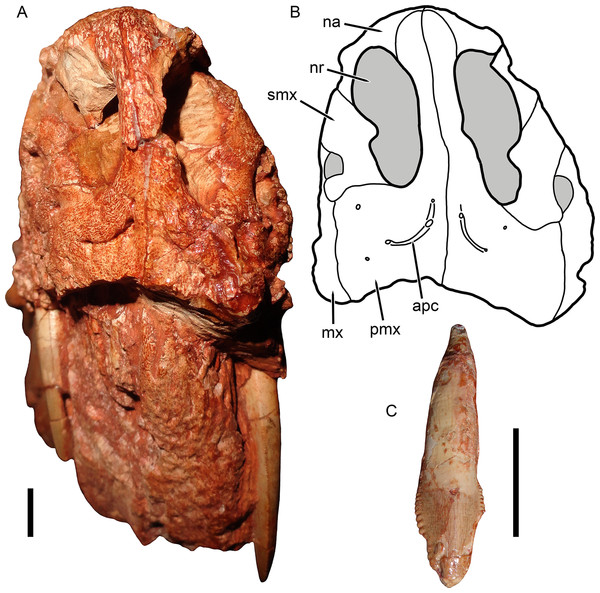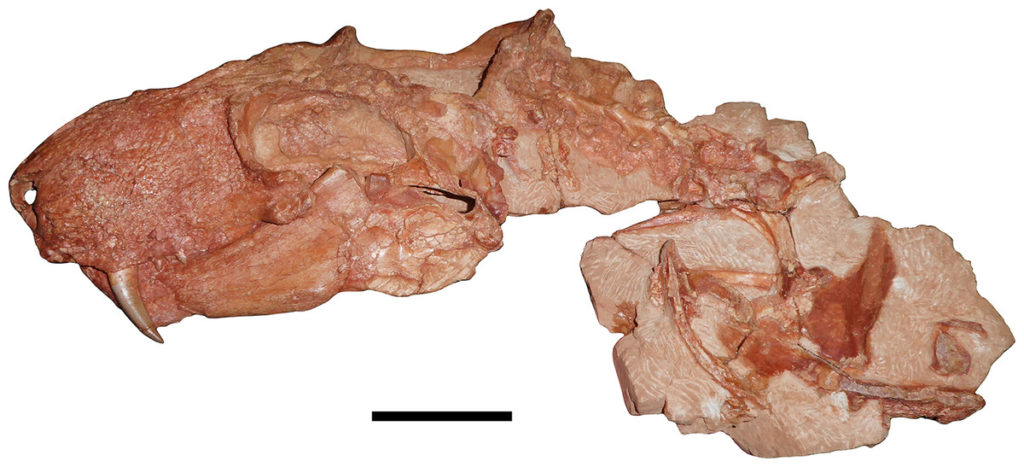@ WFS,World Fosssil Society,Riffin T Sajeev,Russel T Sajeev
A new therocephalian (Gorynychus masyutinae gen. et sp. nov.) from the Permian Kotelnich locality, Kirov Region, Russia
(2018) A new therocephalian (Gorynychus masyutinae gen. et sp. nov.) from the Permian Kotelnich locality, Kirov Region, Russia. PeerJ 6:e4933https://doi.org/10.7717/peerj.4933
A new therocephalian taxon (Gorynychus masyutinae gen. et sp. nov.) is described based on a nearly complete skull and partial postcranium from the Permian Kotelnich locality of Russia. Gorynychus displays an unusual mixture of primitive (“pristerosaurian”) and derived (eutherocephalian) characters. Primitive features of Gorynychus include extensive dentition on the palatal boss and transverse process of the pterygoid, paired vomers, and a prominent dentary angle; derived features include the absence of the postfrontal. Gorynychus can be distinguished from all other therocephalians by its autapomorphic dental morphology, with roughly denticulated incisors and postcanines. Phylogenetic analysis recovers Gorynychus as a non-lycosuchid, non-scylacosaurid therocephalian situated as sister-taxon to Eutherocephalia. The identification of Gorynychus as the largest predator from Kotelnich indicates that therocephalians acted as apex predators in middle–late Permian transition ecosystems in Russia, corroborating a pattern observed in South African faunas. However, other aspects of the Kotelnich fauna, and Permian Russian tetrapod faunas in general, differ markedly from those of South Africa and suggest that Karoo faunas are not necessarily representative of global patterns.
@WFS,World Fosssil Society,Riffin T Sajeev,Russel T Sajeev
Recent expeditions by the Vyatka Paleontological Museum have collected a wealth of spectacularly-preserved Permian fossils near the town of Kotelnich along the Vyatka River in European Russia. These fossil discoveries include the remains of two previously unknown species of predatory protomammals, newly described in the journal PeerJ by Christian Kammerer of the North Carolina Museum of Natural Sciences and Vladimir Masyutin of the Vyatka Paleontological Museum. The first of the two new species, Gorynychus masyutinae, was a wolf-sized carnivore representing the largest predator in the Kotelnich fauna. The second new species, Nochnitsa geminidens, was a smaller, long-snouted carnivore with needle-like teeth. Gorynychus belongs to a subgroup of protomammals called therocephalians (“beast heads”), whereas Nochnitsa belongs to a different subgroup called gorgonopsians (“gorgon faces”).
@WFS,World Fosssil Society,Riffin T Sajeev,Russel T Sajeev

Anterior snout and dentition of Gorynychus masyutinae.
(A) Photograph and (B) interpretive drawing of the skull (KPM 346) in anterior view. (C) Disarticulated incisor (KPM 348) associated with skull in presumed anterior or anterolateral view. Abbreviations: apc, anterior premaxillary channel; mx, maxilla; na, nasal; nr, naris; pmx, premaxilla; smx, septomaxilla. Gray coloration indicates matrix. Scale bars equal 1 cm. Photographs and drawing by Christian F. Kammerer.
Both new species are named after legendary monsters from Russian folklore, befitting their menacing appearances. Gorynychus is named after Zmey Gorynych, a three-headed dragon, and Nochnitsa is named after a malevolent nocturnal spirit. (Based on their relatively large eye sockets, it is likely that Nochnitsa and its relatives were nocturnal.)
Gorynychus and Nochnitsa improve scientists’ understanding of ecosystem reorganization after the mid-Permian extinction (260 mya). Although not as well-known as the more devastating end-Permian mass extinction (252 mya, which nearly wiped out protomammals), the mid-Permian mass extinction also played a major role in shaping the course of protomammal evolution. In typical late Permian ecosystems, the top predators were giant (tiger-sized), saber-toothed gorgonopsians and therocephalians were generally small insectivores. In mid-Permian ecosystems, by contrast, these roles are reversed. At Kotelnich, the saber-toothed top predator Gorynychus is a therocephalian and the only gorgonopsians are much smaller animals.
“In between these extinctions, there was a complete flip-flop in what roles these carnivores were playing in their ecosystems — as if bears suddenly became weasel-sized and weasels became bear-sized in their place,” says Kammerer. The new species from Russia provide the first evidence that there was a worldwide turnover in predators after the mid-Permian extinction, and not just a localized turnover in South Africa.
Kammerer adds, “Kotelnich is one of the most important localities worldwide for finding therapsid fossils — not only because they are amazingly complete and well-preserved there, but also because they provide an all-too-rare window into mammal ancestry in the Northern Hemisphere during the Permian.”



 June 13th, 2018
June 13th, 2018  Riffin
Riffin 
 Posted in
Posted in 
It is truly perfectly written.
I loved your article.
Good day I am so grateful I found your weblog, I really found you by error, while I was looking on Bing for something else, Nonetheless I am here now and would just like to say thanks a lot for a remarkable post and a all round entertaining blog (I also love the theme/design), I don’t have time to go through it all at the moment but I have book-marked it and also added your RSS feeds, so when I have time I will be back to read a great deal more, Please do keep up the great job.|
I like your articles, I am a close follower of yours.
Nice article.